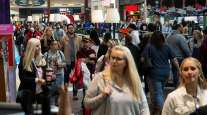Consumer Spending Little Changed as Income Gains Cool

Consumer spending was little changed in August as income growth cooled, pointing to a softening in consumption after a run of strong gains.
The August result followed a 0.4% advance the prior month that was revised up, Commerce Department figures showed Sept. 30. The median forecast in a Bloomberg News survey called for a 0.1% increase. Income climbed 0.2%, while inflation-adjusted spending dropped for the first time since January.
The data are consistent with projections that consumer purchases will provide a smaller but respectable contribution to economic growth this quarter after the strongest quarterly advance since 2014. While robust employment and healthier finances are underpinning household spending, bigger paychecks would help provide an even larger boost.
“It was a soft month for consumer spending following a strong one, and it’s not anything to get worried about,” said Tom Simons, a money-market economist at Jefferies in New York. “The consumer is still going to be the driver of growth this quarter although not as much as the second quarter. Based on slowly accelerating wage growth and recent data on confidence, I’m optimistic about the outlook for consumer spending.”
The gain in personal income was the weakest since a decline in February and reflected a slowdown in worker pay. Wages climbed 0.1% in August after 0.5% gains in the previous two months.
Disposable income, or the money left over after taxes, softened to a 0.1% gain after adjusting for inflation. It rose 0.3% in the prior month.
Adjusting consumer spending for inflation, which generates the figures used to calculate GDP, purchases fell 0.1% after climbing 0.3% the previous month. The decline in August matched a January decrease that was the largest since the start of 2014.
Gross domestic product expanded at a 1.4% annualized rate from April through June, more than initially estimated, Commerce Department figures showed Sept. 29. Household purchases jumped 4.3%, the most since 2014, while business investment stayed weak.
Forecasts for August consumer spending ranged from a 0.1% drop to a 0.4% increase, according to the Bloomberg survey. The previous month’s reading was initially reported as a gain of 0.3%.
The saving rate rose to 5.7% from 5.6%.
Purchases of durable goods, which include automobiles, decreased 1.3% after adjusting for inflation. That followed a 2.3% surge.
Household outlays on services rose 0.1% after adjusting for inflation, the weakest since a drop in March. The category includes tourism, legal help, health care, and personal care items such as haircuts, and is typically difficult for the government to estimate accurately.
The Federal Reserve’s preferred measure of inflation picked up, the report showed. The price gauge based on the personal consumption expenditures index increased 0.1% from the prior month and was up 1% from a year earlier.
The core price measure, which excludes food and fuel, rose 0.2% from the prior month and was up 1.7% from August 2015. Inflation hasn’t reached the Fed’s 2% goal since 2012.
The Fed’s preferred measure is “continuing to accelerate slowly,” said Simons. “Slow progress toward the inflation goal is exactly what the Fed wants to see. We’re getting there.”



